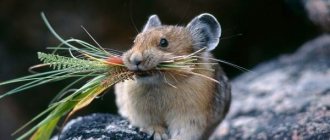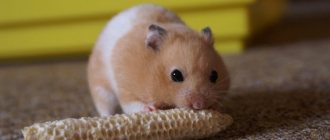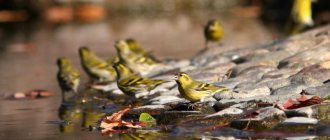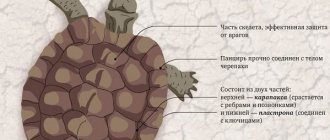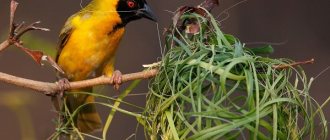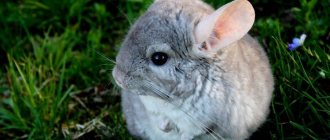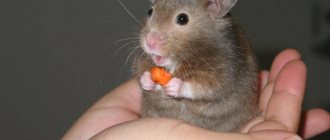Description of the rodent
— Advertising —
Hamsters are small rodents with a dense build, short legs, small ears and short tails. The body length ranges from 5 to 34 cm, the tail is from 0.7 to 10 cm in length. Females can exceed males in size. The fur is thick, the back is colored from ash or brownish-gray to dark brown-ochre. The abdomen is found in black, white or gray. There is a pronounced black stripe on the back. Hamsters also differ from other types of rodents in having well-developed cheek pouches.
Hamster nutritional features
Hamsters belong to omnivorous rodents, but their diet is dominated by plant foods. In addition, hamsters feed on insects and their larvae, small vertebrates (mice, reptiles and amphibians). In the autumn, they switch to seeds and tubers, and also store them in quantities from 0.5 to 11-16 kg. Sometimes hamsters' storerooms with grains and potatoes reach 90 kg. Hamsters also bring grain, peas, rice, millet, buckwheat, lupine, corn, lentils, potatoes to the pantries, putting different varieties of seeds separately. The hamster feeds on these reserves in the winter, temporarily waking up from hibernation, and in the spring until fresh food becomes available.
The hamster carries food in its cheek pouches, which contain about 46 g of wheat. Can carry food for about 1 km.
Hamster spread
— Advertising —
Hamsters are widespread in Central and Eastern Europe, Asia Minor, Syria, Iran, Siberia, Mongolia, northern China and Korea.
The largest populations live in the forest-steppe and steppe. In the south it prefers damp areas, such as river valleys. In the mountains it is found at altitudes up to 3600 m above sea level, up to mountain meadows and forests. It also develops cultivated areas, such as rice fields, forest belts, parks, orchards, vegetable gardens, and residential buildings. Prefers dense soils, rare on sandy soils.
Common types of hamster
Common hamster (Cricetus cricetus)
The body length of adult males is 27-34 cm, the tail is 3-8 cm long, weight is about 700 g. The tail becomes thinner towards the end, covered with short, stiff hairs. The ears are short and dark. The fur is thick and soft. The color is bright and contrasting. The back is reddish-brown, the belly is black. On the sides there are two large light spots separated by black fur. There are also light spots on the sides of the head and behind the ears. There are specimens that are black or black with white spots on the legs and neck. In total, more than 10 subspecies of the common hamster have been described. The color becomes lighter from north to south, body size increases from west to east and from north to south.
The species lives in the meadow and forest-steppe of Eurasia from Belgium to Altai and Northern Xinjiang.
Syrian hamster, or Central Asian hamster (Mesocricetus auratus)
Body length is about 13 cm, tail up to 1.5 cm. Weight ranges from 100 to 125 g. The fur is soft, thick, golden.
It is found in nature near the Syrian city of Aleppo and in eastern Turkey.
Brandt's hamster or Transcaucasian hamster (Mesocricetus brandti)
Body length 15-18 cm, tail length 2-3 cm. Weight up to 300 g. Ears are small. The back is earthy brown. The belly is brownish-gray, there is a black spot on the chest. The sides of the head are yellowish-red, there are long black spots under the ears, and the chin is white. Paws are white. The fur is soft and thick on the tail.
The species' habitat includes Turkey, Israel, Lebanon, and the eastern Ciscaucasia. Inhabits steppes on mountain slopes, mountain meadows and cultivated areas.
Radde's hamster or Cis-Caucasian hamster (Mesocricetus raddei)
Body length up to 28 cm, tail length about 1.5 cm. The back is brownish. The belly is black or dark gray. There are light spots on the cheeks and behind the ears.
Distributed in Georgia and Russia, in the North Caucasus, in the Stavropol Territory and in the Ciscaucasia, in the steppes and forest belts.
Newton's hamster (Mesocricetus newtoni)
Body length 14-17 cm, tail length up to 2 cm, weight 80-150 g. The back is gray-brown, with a black stripe running down the center of the back. The neck and chest are black-brown, the belly is yellowish-gray.
Found along the Danube, in Bulgaria and Romania.
Djungarian hamster (Phodopus sungorus)
Body length up to 10 cm, weight 35-65 g. The gray back is decorated with a dark stripe, the tail is short. Fur with white spots.
Inhabits dry steppes and semi-deserts in the south of Western Siberia, Dzungarian Alatau, and Khakassia.
Campbell's hamster (Phodopus campbelli)
Body length is 7-10 cm, the tail is short, up to 1.5 cm long, weight is about 25 g. The head is rounded, the muzzle is short. The fur is dark gray with a brown tint, there is a dark stripe on the back, and the belly is gray.
The species is distributed in Mongolia, northern China, Russia and Kazakhstan.
Roborovski's hamster (Phodopus roborovskii)
A small species with a body length of 4-5 cm, weighing about 30 g. The head and back are sandy-golden, the abdomen is white. Light spots are visible above the eyes.
Found in Mongolia, China and Russia.
Short-tailed hamster (Cricetulus alticola)
Body length is 8-10 cm, weight ranges from 22 to 48 g. The fur is gray-yellow-brown without spots.
It lives in the north of South Asia and China, at altitudes of about 4000 m above sea level, in coniferous and birch forests, and in the steppes.
Barabinsky hamster (Cricetulus barabensis)
Outwardly similar to an ordinary hamster. Inhabits forest-steppe and semi-deserts in the south of Western Siberia, Tuva, Transbaikalia, Mongolia, northeast China, Primorye (Russia) and Korea.
Gray hamster (Cricetulus migratorius)
Body length 10-13 cm, tail 2-3.5 cm long. The coat is gray on top, the belly and tail are light. The eyes are large. The ears are small.
The species' habitat includes Eastern Europe, Russia, Asia to western China.
Sokolov's hamster (Cricetulus sokolovi)
Body length from 7 to 11 cm, tail length up to 3 cm. The back is gray with a dark stripe. The abdomen is light gray. There are dark brown spots in the center of the ears.
Found in sandy areas of Mongolia and China.
Mongolian hamster (Allocricetulus curtatus)
A small species with a body length of 10-15 cm, a tail 1.5-2 cm long. The color is light, the tummy, tail and paws are white. The tail is fluffy.
It lives in the Zaisan depression in the south of Tuva, China and Mongolia.
Eversman's hamster (Allocricetulus eversmanni)
Body length 13-16 cm, tail 2-3 cm long. Paws are short. The ears are small. The tail is wide, flattened, densely pubescent. The fur is short, soft, velvety. The back is blackish-brown or fawn-red or ash-sandy. The belly is white with a sharp border on the sides. There is a brown spot on the throat and chest. The paws and tail are white below.
Lives in the Lower and Middle Trans-Volga region, in the south of the Trans-Urals, in Kazakhstan.
Kansky hamster (Cansumys canus)
Body length from 10 to 17 cm, tail 7-10 cm. Weight from 60 to 120 g. The coat is thick, the back is gray with white spots on the cheeks and near the ears. The belly and tip of the tail are white.
The species is distributed in central China.
Rat-like hamster (Tscherskia triton)
Body length from 14 to 25 cm, tail 7-10 cm long. Weight from 92 to 241 g. The back is light gray-brown, the tail is dark brown with a white tip, the paws are white.
The habitat includes northeast China, the south of Primorsky Krai, and Korea.
Body structure
Hamsters look harmonious and proportional.
The structure of their body is characterized by the following features:
| Body type | Dense, knocked down |
| Body length (excluding tail) | 5–35 cm |
| Weight | 30–700 grams |
| Head | Not very large, round, on the muzzle there are hard whiskers (“whiskers”) of a dark color. |
| Ears | Small, rounded, on the outside the ears are covered with dark hairs, finer than the main fur. |
| Eyes | Little ones |
| Tail | Short, no more than 10 mm. It is thick at the base, then sharply tapers into a triangle shape. May be bare or covered with coarse and short hairs |
| Paws | Small but strong, with wide hands and feet. The toes have hard and strong claws, with the help of which the animal is able to dig holes even in very dense soils. Some species have bare limbs, others are covered with hair (this group is called “hair-footed”) |
| Wool | Thick and soft |
| Teeth | Sharp, strong. Teeth have no roots, but they grow throughout the rodent’s life. |
A distinctive feature of hamsters is the presence of special muscle cavities located in the lateral parts from the inner surface of the cheeks to the neck and very shoulders. These are the so-called cheek (or cheek) bags. For the rodent, they act as a kind of container into which the animal loads large supplies of food and then transfers them to the hole, where a stationary storage facility has already been installed, allowing the animal to be provided with food throughout the winter.
The presence of cheek pouches can make a hamster's life much easier. In addition to carrying food, the animal can use this feature of its physique for more original purposes, for example, swimming. The animal fills the volumetric cavity in the upper part of its body with air and thus receives an excellent “life preserver.”
Did you know? Cheek pouches are found not only in hamsters, but also in other rodents, including ground squirrels, chipmunks, harelips, pouched rats, and gophers. It is interesting that many species of monkeys have the same formations, but vultures, wolves and coyotes in the process of evolution have learned to use a safer place to transport food - their own stomach.
Hamster behavior
Hamsters are terrestrial animals; some species can swim by taking air into their cheek pouches. They usually live alone, in burrows. Outside the breeding season, hamsters behave aggressively towards their relatives and often start fights. In winter, they fall into a prolonged torpor, which is still not real hibernation.
Hamsters are characterized by a twilight lifestyle. During the day they remain in their burrows, which reach 8 m in length and 1.5 m in depth. May occupy gopher burrows. In a permanent burrow there are from 2-5, sometimes up to 10 exits, a nesting chamber and storerooms.
There are both pros and cons to keeping hamsters at home.
Would you like to get a cute fluffy rodent, but can’t decide? Perhaps the lists of pros and cons of these miniature animals will help you make the right choice.
Advantages and disadvantages
The advantages of hamsters include:
Affordable price (the cost of a hamster is much lower than a guinea pig or chinchilla)
Doesn't take up much space in the apartment
Does not require complex long-term care
There will be no dirt or clumps of fur in the house, such as from cats and dogs
These peaceful and friendly creatures easily make contact with humans.
They do not need constant attention and communication
It’s very interesting to watch the antics and fuss of funny rodents
You don’t have to waste time preparing food and creating a balanced menu; you just need to buy special food in the store
Disadvantages include:
Low life expectancy
Not a very pleasant smell (if the cage is not cleaned on time)
They can bite, and it hurts very much.
They make noise at night, preventing the owners from sleeping
Fragile animals are prone to injuries and fractures, so they require careful handling
If the hamster escapes, it will be difficult to find and catch it
Once upon a time, a hamster in the house was exotic, but now these animals have firmly entered the human world. Fluffy rodents were and remain amazing creatures, because for many centuries they have been fighting for survival in the wild, and, despite all adversities, they confidently win. Well, at home, such an animal will give its owner positivity, delighting with its funny appearance and amusing tricks.
Pet hamsters
At home they keep Syrian, Djungarian, Campbell and Roborov hamsters. Syrian hamsters come in a wide variety of colors, patterns, and coat types. Long-haired Syrian males are sometimes mistakenly called "Angora".
When choosing a hamster, take into account that Roborovsky hamsters can live in flocks, while other species are solitary, and when they are kept together, fights arise, which often lead to the death of the weaker of the hamsters. When hamsters of different sexes are kept together, the female gives birth very often, which harms her health and shortens her life. A pregnant female is capable of killing or injuring a male while protecting her cubs.
The dimensions of the cage for hamsters must be at least 50 cm by 30 cm. A wheel with a running surface (14-18 cm in diameter) must be installed in the cage. Eating at home is no different from eating in nature. The diet is based on cereals and green plants.
For mating, a pair is selected from a male aged 4 months and a female aged from 9 months. They are brought together on neutral territory or in a male’s cage during the female’s estrus period, which occurs for several hours every 4 days. Pregnancy lasts from 17 to 20 days. At the age of 4 weeks, the young animals are separated from the female, separated by gender.
Reproduction and raising of offspring
Hamsters become sexually mature very early. Actually, both females and males are ready for procreation, reaching two months of age. The breeding season for these animals lasts from April to October. During the winter months, hamsters become inactive and practically do not crawl out of their burrows, eating accumulated reserves. But zoologists sometimes record cases of cubs being born in December, and this usually happens during an abnormally warm and snowless winter.
Unlike their wild counterparts, domestic hamsters breed all year round, since when kept in an apartment, their home always has a comfortable temperature and enough food.
Features of the mating season
As already mentioned, in their natural environment, hamsters lead a solitary lifestyle. They do not form strong mating unions, although some males have a kind of personal “harem” consisting of 3-5 females. True, he lives in different burrows, but the females live in the controlled territory of their “husband,” and he jealously protects them from the encroachments of foreign males.
The female and male meet only to mate
Hamsters do not have mating games, there is only a short period of courtship. To put the female in a romantic mood, the male marks the territory near her burrow with an odorous substance and brings gifts to the capricious lady in the form of grains, tree branches and tasty larvae.
As soon as the female responds favorably to the courtship, the couple in love retires to the hole for the whole day to mate. After mating games, the male leaves and does not take any part in raising the offspring.
Pregnancy and caring for babies
Recommended by topic
Kangaroo Lark Orangutan
A female hamster carries babies for 16-18 days, so she is able to bear offspring 2-3 times a year. Depending on the type of rodent, there are from 3 to 18 cubs in one litter.
Babies are born bald and blind, but newborn hamsters already have tiny incisors. Small hamsters can eat plant foods already in the second week of life, but for another month their main diet is mother's milk.
The cubs develop very quickly; in the second week they open their eyes, become covered with soft fur and look like a miniature copy of their parents. The female takes care of the babies until they grow up, takes them for walks, and teaches them to recognize the sounds made by predators. And if a furry mother notices a fox or ferret near her hole, she hurries to move the offspring to another, safer home.
Female hamsters are very caring and attentive mothers.
Sometimes females adopt other people's cubs and raise them along with their own offspring. But there are cases when females eat their babies. This happens when there is a shortage of food in a dry year, and also if there are too many babies in the litter, and the female understands that she cannot feed them all.
Interesting facts about the rodent:
- The word “hamster” is of Old Church Slavonic origin, in turn borrowed from ancient Iranian, where “hamaēstar” is translated as “an enemy who throws to the ground.” This probably indicated that the hamster bends the stem of the cereal towards the ground and thus gets the seeds.
- The Syrian and Newton's hamsters are included in the International Red Book.
- Hamsters cause damage to agriculture as they feed on legumes and grain crops. In addition, they are carriers of pathogens of a number of infectious diseases, which is why their keeping is prohibited in Vietnam. The maximum fine for violation is 30 million VND, which is equal to the annual income of a resident of this country. But hamsters also bring benefits. For example, the skins of certain types of hamsters are harvested. Hamsters are also used as laboratory animals and pets.
Conservation status
The Transcaucasian hamster is protected in Georgia because it is in danger of extinction. A gray hamster was taken under protection in Russia in the Lipetsk and Tambov regions. In the Nizhny Novgorod region and the Republic of Tatarstan, the animal is included in the Red Book. The gray hamster has a special status in the Penza region.
To save Alsatian hamsters (a unique species) from extinction in France, 3 million euros were allocated. According to the European Commission, the importance of protecting wild hamsters is constantly growing. In fact, these furry animals are part of the ecosystem. Its proper functioning depends on the balance created by a number of living and interacting organisms.
